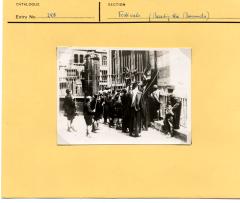ENGLAND: THE OTHER WITHIN
Analysing the English Collections at the Pitt Rivers Museum
Oxfordshire before 1974
Alison Petch,
Researcher 'The Other Within' project
Beatrice Blackwood was taught in the Pitt Rivers Museum and later worked there from 1936 as Demonstrator in Ethnology until her death in 1975. She is known for her pioneering work on museum documentation and also for her fieldwork in New Guinea and North America. However, she was also interested in English folklore, ethnography and archaeology.In an article she wrote with Leonard Halford Dudley Buxton [1], An introduction to Oxfordshire Folklore, they described Oxfordshire as they saw it. The article was published in Folklore, the journal of the Folklore Society (to which they both belonged), in March 1934 and thus describes historic Oxfordshire, before northern Berkshire was added to the county in 1974.
The article is interesting because it gives a view of how someone, who was shortly to work in the Pitt Rivers Museum (and already knew and worked informally with its curator, Henry Balfour), thought of Oxfordshire and its folklore. Parts of this article are reproduced here both from historic interest, to give a flavour of a pre-1974 Oxfordshire, and to show the kinds of ways people who collected in Oxfordshire thought of the county. The article, rather than being interested in folklore, reflects the interests of the authors in the humans who had lived in the county since early times, and the evidence for their existence.
'Oxfordshire lies close to the centre of England. It has in times past been the meeting-place of conflicting cultures, and it would be difficult to find another region where there is such a variety of remains belonging to the different periods of British and English history. The reason for this lies in the geographical surroundings. In this region there run across the country in a general SW.-NW. direction two scarps. The more southerly forms the Berkshire Downs, and is continued eastwards in the Chiltern Hills. The Chilterns, to use a generic name for the whole range, consist of underlying chalk, often with a clay covering, which forms a heavy and intractable soil. This range is cut by the Thames at Goring. Secondly there is the great Jurassic escarpment which forms the Cotswolds Hills. Much of the latter is limestone, well-drained and easily worked. The region between the two ranges consists for the most part of heavy but fertile clays. ... (the paper here discusses the changes to Oxfordshire over time, and the growth of settlements) ... Summing up, it may be said that we have in our district certain dry regions which have always been open to external influences. We have in addition certain riparian regions which offered a ready place for settlement to those who approached them by river. At the same time there was a singularly unapproachable hinterland, of damp clay soil, probably settled late, and once settled, a region still very difficult of access from the outside, till all the region was intensively settled. In these areas of singular isolation old customs have survived while the rest of the country has moved forward. The contrast between Hopcroft's Holt, with its gaudy petrol pumps and traffic control, and Noke,[2] with sedges and rare wild plants, is probably no more striking to us than the contrast between the old British settlements and the wealthy villas of the Cotswolds was to our predecessors fifty generations ago.
... Oxfordshire does not seem to have been continuously settled until Saxon times. Before then the population was, if we may put it in this way, rather of the colonial type inhabiting small clearings on the land which happened to suit the type of culture of the people ... ' ['An introduction to Oxfordshire folklore' L.H. Dudley Buxton and Beatrice Blackwood, Folklore, vol. 45 no. 1 (March 1934) pp. 29-46.]
It is hoped that more information about Blackwood and Buxton's work in Oxfordshire will be published in the June or December 2008 History of Anthropology Newsletter.
[1] 1889-1939 University Reader in Physical Anthropology from 1928, worked with Blackwood in the University Museum (of Natural History) at Oxford where they were both interested in human remains. In the article they refer to the collections they worked on, 'Thanks to the labours especially of Professor Rolleston in the past, and of Mr Leeds now, we have a very fine series of skeletons from the Oxford district. ... It is possible to measure them very accurately in the laboratory and to study in great detail one important part of the culture they represent, i.e. burial customs. ... We have not been able to collect an adequate series of skulls of modern Oxfordshire folk. The measurements on the living, however, ... ' [pp. 34-35, 37]
[2] It is not known why Hopcroft's Holt and Noke were chosen as contrasts, both Blackwood and Buxton lived within Oxford, the places must have been chosen for their personal resonances or because they were then infamous in Oxfordshire for remoteness and its reverse. Hopcroft's Holt is a crossroads on the A4260, at the junction with the B4030, between Oxford and Deddington. It now appears to be a quiet crossroads with a former coaching inn (now hotel) called the Holt Hotel and a garage. Noke is a small village off the B4027 5 miles north-east of Oxford. It is on the southern rim of Otmoor. Otmoor is an area of former marshland now wetland and grassland, part of it is now a nature reserve. It is known for its peaceful atmosphere and seclusion. See http://en.wikipedia.org/wiki/Otmoor for more information about the local area. We do not have artefacts from either place in the PRM collections.


